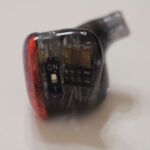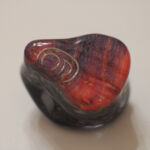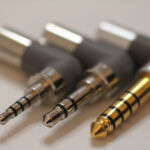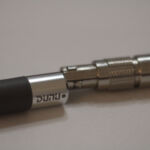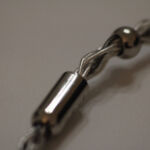Dunu Studio 6 (Sa6)
disclaimer: The Sa6 was loaned to me by Ngoshawk Sounds. He had mentioned thinking the Sa6 was on the short list of models worth auditioning at the roughly $500 mark and having previously reviewed the Sa3 I had an interest in seeing how much different and improved the big brother of the Sa3 is. Thanks to Ngoshawk Sounds for the loan. I have no financial interest in Dunu or any of its distributors.
Unboxing / Packaging:
The new studio SA6 comes in a Rainbow sunset outer carton with the name on front and specs on reverse. Inside that, a black press-board lift top style box protects the contents. Inside the case, one finds a softcase with foam tabs protecting it from shifting within the box. All of the kit was inside the softcase when the Sa6 arrived at my doorstep with each item neatly packed in its own plastic bag (heavy plastic) to protect the parts from getting scratched up. The kit consists of earpieces, cable, case, and 3 sizes of 3 different types of silicone tips. The tips I received appear to be spinfits or a close copy there of. Foams are not included. Again, since this is a borrowed kit, I am quick to point out that others may receive slightly different amenities with their order. The case is well made and large enough not to cramp the contents but a side pocket to carry an additional jack (more on these later) without having it loose in the case to scratch the earpieces would be a welcome addition.
Build/Fit:
The Shell is a 2 part affair in the now common semi-custom shape with a 3d-printed resin inner shell that includes the nozzle and a colored stabilized wood faceplate. The faceplates have Dunu in gold on one ear and 6 on the other when combined with the pattern and colors in the wood this about guarantees a unique faceplate an each one made. Nozzles exit the bottom front with a forward rake and allow for deep insertion that improves isolation. Nozzles very much like the Sa3 are part of the shell and not an additional part but have 3 sound bores instead of the single of the Sa3. Since the Sa6 is an all BA model, venting is not required or present. The bi-pin connectors are recessed so require a cable with a matching step for proper fit. Tuning is via a single dip switch found at the rear of the inner shell just inside the faceplate. Each earpiece has SA6 and either L or R on the underside but these can be hard to see due to the transparent shell and the dark coloration of the lettering. Size is moderate and really no larger than the Sa3 and was very comfortable for me for extended periods with little or no physical fatigue.
Internals:
The Sa6 does share internal similarities to the Sa3 as well. It is an all balanced armature model with dual packages used throughout. Bass drivers are the Sonion AcuPass Vented Dual woofer which is one of the 33AJ007i family of drivers. I prefer the Sonion to the Knowles CI as I think bass depth and weight is improved on the Sonion compared to the Knowles. Mids and Treble are both handled by pairs of Knowles drivers that Dunu lists as customized versions of the DTEC and SWFK series respectively. The Sa6 has a higher impedance than many will expect for an in-ear at 60Ω but a high sensitivity of 113 dB/mW helps offset that some. The Sa6 does need a bit more power than the average phone can provide but was fairly good with the LG forced into high output mode so that can be thought of as sort of a minimum entry point for powering the Sa6 well. The Sa6 scales quite well both qualitatively and quantitatively with better sources so using a dap or amp with some additional power coxes the best out of it.
Cable:
I gotta get me one of these. The cable provided with the Sa6 is a very well thought out design. It comes with 3 90º jacks in 2.5mm, 3.5mm and 4.4mm respectively. The user chooses which to use and it latches into the connector (Dunu calls it the Quick-switch modular system) on the cable very solidly without being overly heavy or bulky in the process. Cable material is 8 core mono-crystalline silver plated copper with 6 strands in clear casing and 2 in dark gray that provides an interesting contrast in the braid. The splitter is a silver barrel that matches the jack housing. A chin slider in the form of a silver bead rests neatly on top of the splitter with 4 wire braids exiting to the earpieces. The cable terminates in pre-formed earhooks and .78mm bi-pin connectors that fit down into recesses in the shells themselves for added strength. This cable is a lighter-weight version of the Dunu Hulk and I think I prefer it as it hits a nice balance between weight, durability, and comfort.
Sound:
Tuning Modes:
Dunu refers to the 2 signatures as default and Atmospheric Immersion. with the switches in the ‘I’ position the default signature gives the Sa6 a fairly balanced overall signature with a mild V adding some energy in mid-bass and a slight lift in the upper-mids/lower treble. With the switches flipped on, Bass is boosted a small amount, the V deepens slightly, and the sound gets a bit fuller and warmer. As shown in the FR below. Changes are subtle, but notable particularly in the lows.
Bass:
Sub-bass is better than expected as I think we can all agree that this is one place balanced armatures struggle to deliver. The Sa6 does a good job of blurring that line a bit, particularly with the atmospheric mode enabled where it delivers a bit fuller warmer sound. Again the atmosphere switch adds a bit of thickness to the mid-bass and slows decay just slightly. Bass drivers here use a ported armature and much like ported speakers, this lets it dig deeper at the expense of some clarity compared to a non-vented model. I have become skeptical when I read about custom tuned armatures as most of the time I think it is more ad-copy than anything else, but in this case I think there is something to the partnership between Dunu and Sonion as these have bass qualities I have not heard in other models sporting the same base Sonion driver. The attributes we do expect from a balanced armature are still on display here as bass is fast with quick attack and just slightly slower decay yielding a clean signature with no perceptible bleed or bloat. Sub-bass probably still is not enough to please the basshead crowd, but it certainly delivers more depth than anticipated while retaining the highly defined mid-bass we expect. Mid bass has more texture and detail than typical of dynamic drivers if slightly less outright slam. With the recent craze of high-tech coatings to improve speed of dynamic drivers with the aim being to improve low end texture and detail, the Sa6 could be easily mistaken for a Be or Ti driver in both detail and speed.
Mids:
Lower mids follow cleanly from the mid-bass with no bleed or obstruction and are slightly less emphasized than the sub-bass bump. It is hard to call anything on the Sa6 recessed as the difference in the high points and the lows are often single digits (dB). Lower-mids have good tonality and male vocals and lower strings benefit from the tuning with good weight and timbre. Guitar growl is good but the speed of decay keeps it from being as assertive as some other models. In atmospheric mode note weight is a bit heavier and the tone is a bit more lush while slightly less detailed. Once we move above the lower mids the atmospheric mode switch no longer comes into the discussion as all the change is from lower-mids down. Mids are well presented with strings having good texture and being closer to accurate than expected if needing a touch more energy to feel entirely realistic. Female vocals do step forward slightly in the mix due to a very mild upper-mid lift but also retain a bit more thickness than entirely natural. Thankfully this lift helps them cut through the instrumentation but does not move them forward enough to feel disparate. Overall, well integrated mids with good vocal textures and well produced strings if not quite energetic enough. As a lover of mids, the Sa6 does a lot well but fails to take that next small step that would make it sound entirely realistic.
Treble:
The lower treble shares the mild emphasis of the upper-mids and brings a lot to this party. Detail is very good and there is more micro-detail than expected which allows the Sa6 to produce fine textural differences that are lost on some other models. I expect a balanced armature to have good speed but the ones used here are fast even for that and in some respects come close to a piezo or stat driver in attack speed. Snare rattle is good with crisp lead edges and fast decay allowing the details to show through. Cymbals are not metallic but again need a touch more energy to feel entirely real. Above the lower treble boost, the true treble falls back quickly and prevents the Sa6 from getting harsh but does have a few bumps that are notable. There is a slight peak at roughly 7-8kHz that is audible and keeps the treble from being entirely even along with another immediately before roll-off at around 12khz that puts back a little air at the top end. Final roll-off is somewhere above my hearing limit (roughly 14kHz) which keeps it from feeling enclosed. Overall the treble tuning goes for clean, polite, and non-fatiguing but as such is not as assertive or aggressive as some will prefer and not quite as linear as others will want.
Soundstage / Imaging:
Soundstage is a bit wider than deep and overall fairly intimate with some sense of height as well. While not massive in any one dimension, the stage is well shaped and doesn’t sound disproportionate. Seating the orchestra is straight forward with no major gaps, misplacement, or overlaps. Instrument separation is very good as expected in an all balanced armature model and layering is equally good with no tendency to compress as tracks get busier. Imaging is also quite good with movement easily tracked and placements on stage being compact and precise. If there is a knock here, there is less precision to movement around center front than their is off-center so small movements in front may be harder to discern. As an example a soloist standing in place during an orchestral performance is less notable if seated next to the conductor vs those further away.
Comparisons:
Dunu DK-3001 Pro –
I have to compare this one as the 3001 exists at the same price point and substitutes the pair of the Sonion BA’s used for bass in the SA6 with a 13mm Beryllium dynamic driver. Shell materials and shapes are entirely different with the Sa6 winning handily for comfort to me. I also prefer the bi-pin of the Sa6 to the mmcx connector of the 3001. Signature wise, the 3001 has more low end grunt while the Sa6 has a bit more mid and treble detail and sounds much more coherent as the driver mix in the Sa6 is harder to identify whereas the handoff from one driver to another is more easily discerned on the 3001. Treble is more aggresive on the Sa6 which affords it better detail, but those who liked the 3001 treble may find the Sa6 a bit hot for their liking.
Dunu Studio 3 (Sa3)-
I felt like I had to go here too. what does the step up from little brother to brother get you? First off the shells are similar in both size and shape and to some degree materials but the faceplates on the Sa6 are a distinct step up aesthetically. Sound wise the two have similar tunings but the Sa6 has more of everything and some of those are key enhancements. Better sub-bass reach, better bass texture and detail, better texture to the mids, more space up top. Everything is a matter of degree and the Sa6 comes away feeling 3 steps above the 3 as the name would seem to imply.
Fiio Fa9-
I had to go here as this is Fiio’s version of the Sa6. Both are 6 BA arrangements with the Fiio using all Knowles drivers with ported bass BAs similar to the Sonion bass drivers used in the Sa6 and both very similar mid and treble drivers as both sport custom tuned Knowles drivers for mids and treble. Both also offer tuning switches and while the Sa6 has a single switch, the Fa9 sports 3 switches with 1 for impedance and the other two true tuning options giving it 4 options compared to the 2 of the Sa6. As one might guess, signatures are similar with the Sa6 being a bit cleaner at the low end and the Fa9 having just a little more sub-bass depth comparatively. Mids are similar but again the Sa6 seems more coherent while the Fa9 seems a little more assertive in its upper-mid push. Treble favors the Sa6 as well with better air at the top end. For my dollar, the Sa6 gets the nod here.
Ibasso IT04-
Similar shapes and shell materials but the IT04 shape seems a more exaggerated version of the Sa6 shell and I find the Sa6 a bit more comfortable as a result. The IT04 is a 3+1 hybrid using a 10mm graphene diaphragm dynamic driver, a single knowles ED balanced armature for mids, and the TWFK dual tweeter (also Knowles). Here again from the mids up similar choices of drivers and to some degree tuning. This one is a slug-fest for sure. The IT04 has deeper bass and a more visceral punch while the Sa6 has a bit more texture and a bit faster decay. Both have great mids with the differences being a matter of personal preference more than technical merit. Highs again great on both but favor the IT04 in overall extension. Here again though, that can translate to a more harsh treble and as such some may well prefer the tuning of the Sa6. Truth be told, these are probably the two best options at the $500 mark and the end user will want to audition both before buying.
Thoughts / Conclusion:
I’ll admit, I have expectations of iems in this price range and expectations of what a Dunu IEM should deliver having owned and reviewed more than a few over the years. Build wise, the Sa6 is gorgeous with its dyed wood face plates and high polish finish so it certainly lives up to the expectations there, but most of us buy iems for how they sound rather than how they look. The Sa6 offers a near reference tuning with the option to use atmosphere to add a gentle bass lift and some additional warmth when desired. It has very good detail, and a near effortless delivery which make it an easy listen for extended periods. It would be easy to think that I didn’t care for the Sa6 sound as I did make a few remarks about things that were less than perfect, but this is a $600 in ear and not the >$1k market space which makes some of those comments a bit unfair. I judge everything on the same scale so expecting something in this price bracket to compete on an even footing with the likes of the EE Legend X or JH 13 is asking a lot. The fact that the Sa6 comes as close as it does is darned impressive and puts it in position to go toe to toe with most models in the $800-$1k range. I found myself switching between it and the Moondrop S8 a good bit. I didn’t include the s8 in my compares due to the price inequality but easily could have as the two are quite close in both build and sound (although the Sa6 is prettier by far). Is the Sa6 inexpensive? No Is it a good value? yes, very much so. Does it deserve your attention? Yes, anyone auditioning iems in the $500-$1k space should take a hard look at the Sa6, it competes very well and may just give you the sound you want and some money left in your pocket to pay your streaming bill.
-
Bass - 8/108/10
-
Mids - 8/108/10
-
Treble - 7/107/10
-
Soundstage - 7.5/107.5/10
-
Imaging - 7.5/107.5/10
Summary
Pros: Spectacular looks, well designed interchangeable jack system, rich tone with good details
Cons: Tuning switch does nothing above the lower-mids and for some will be more gimmick than useful, treble can be uneven








